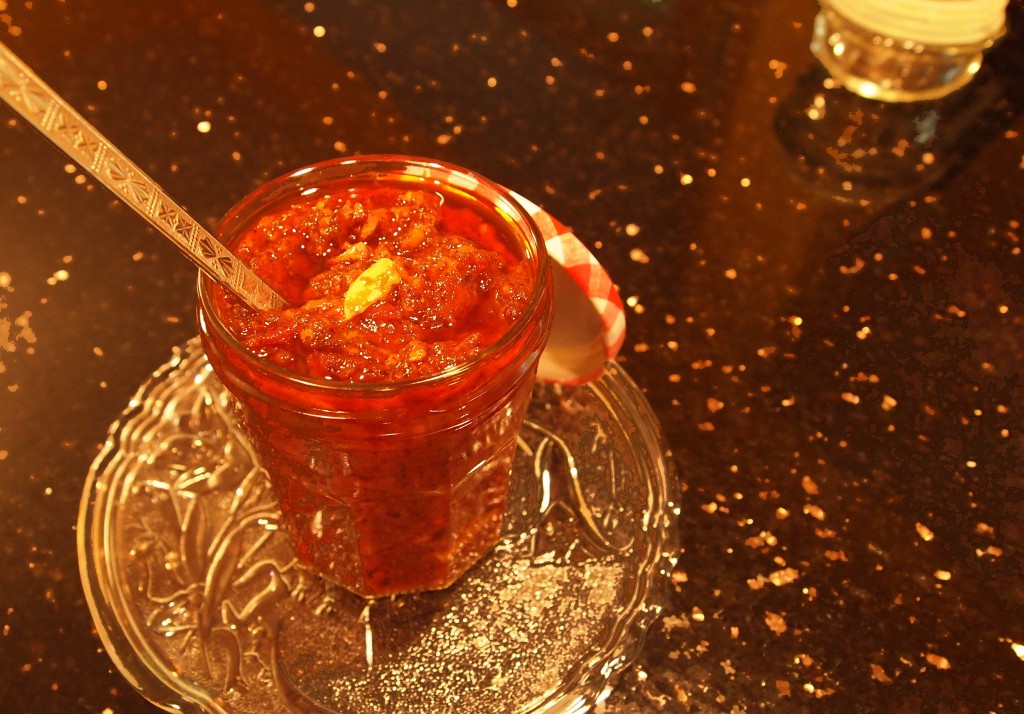
Here is the recipe that started it all. Pickling is usually a process that takes days if not weeks, but in less than a couple of hours, you could have on your hands this tomato pickle designed to delight your taste buds and impress your guests.
Ingredients:
¼ cup + ¼ cup vegetable oil
8 tomatoes washed, wiped thoroughly dry and chopped into a small dice (about 5 cups)
2 tbsp tamarind, seeded, fiber removed, cleaned and chopped coarsely
1 tsp roasted fenugreek seed powder (seeds roasted and powdered)
3 tbsp roasted mustard seed powder (seeds roasted and powdered)
1½ tbsp jaggery
1 to 3 tbsp chilli powder (see Tips below for note on quantity)
Salt to taste (about 1½ to 2 tsp)
8 large cloves garlic peeled and crushed
Method:
Heat ¼ cup oil in a large, round bottomed heavy frying pan (a cast iron wok works very well) until shimmering. Add the chopped tomatoes and tamarind and cook uncovered, stirring frequently over a high flame at first, until the mixture comes to a boil, and then over a medium flame. Cook until most of the juices evaporate and about half the original volume of the tomatoes and tamarind is left, about 30 to 40 minutes.
Add the fenugreek powder, mustard powder, jaggery, chilli powder and salt, mix thoroughly and let cook over low flame for about 10 minutes. The juices will evaporate even more.
In a separate small wok or frying pan, heat the remaining ¼ cup oil. Add the crushed garlic. Make sure the oil doesn’t smoke. Sauté until the garlic turns golden. Add the oil/garlic mixture to the tomato paste and mix thoroughly. Cook for a further 10 minutes over low flame. The pickle is done when the oil starts to float on top.
Turn off the stove and let cool completely before transferring the pickle to a glass or ceramic jar.
How to Serve:
Tomato Pickle is usually served with hot rice, rotis or dosas (savory pancakes), but it also makes for a wonderfully tasty spread with buttered toast. You could even use it as a spread for a roasted vegetable sandwich.
Notes:
1. Make sure the tomatoes are completely dry and all implements you use in the making of this pickle are completely dry. Any contact with water means you might not be able to preserve it for a length of time. It is not necessary to store the pickle in the fridge, but you could if you wanted to.
2. One cup = 8oz (US).
3. Tomato: Use a variety of tomato that is flavorful. Vine-ripened tomatoes work very well. As you are chopping the tomatoes, discard any juice that might collect on the cutting board, but don’t try to squeeze out the pulp as the seeds and pulp are nutritious.
4. Tamarind: Be very thorough in cleaning the tamarind, taking care to discard any seeds, strings, and pieces of the outer covering that might still be sticking to the fruit.
5. Chilli powder: This ingredient is best purchased at an Indian grocery store (paprika is not recommended). The recipe calls for three tablespoons of chilli powder. North Karnataka recipes sometimes use a special type of chilli called Byadgi. Named for the town from which it comes, the chilli is famous for its deep, rich red color, but is not very spicy. You can get away with using even four tablespoons here. But, if you are not using the Byadgi variety of chilli powder, please use caution. The regular chilli powders available at Indian grocery stores are usually very hot even though they might not be fiery red in color. You might try using one tablespoon first to see if you can withstand the heat. Add small amounts until the pickle is satisfyingly spicy. Continue cooking and stirring on a low flame for ten minutes after you add the last of the spices before you move on to the next step.
Sujatha Bagal is a Washington, D.C.- based freelance writer and blogger. Her essays, articles and stories have appeared in various online and print publications, including Pregnancy, Mint, ForbesLife India and The Smart Set (links are available at www.sujathabagal.com/category/












